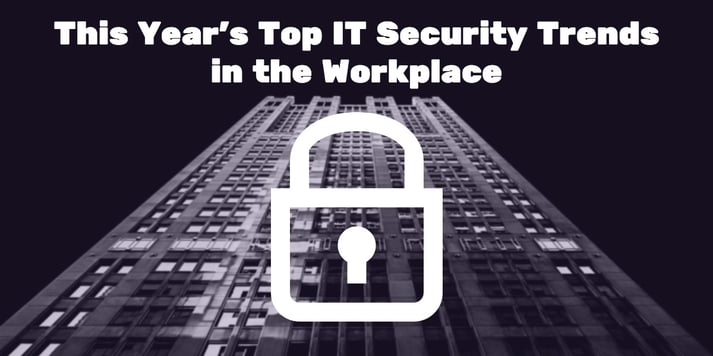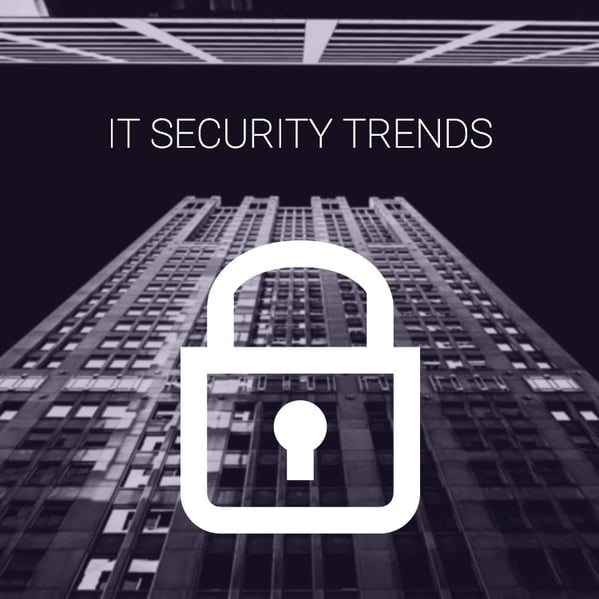
On the heels of one of the most vulnerable and insecure years in the cyber world, IT security will not be taken lightly in 2017. We’ve seen victims from the everyday consumer to corporate giants. As the cloud and Internet of Things (IoT) transform the way we live and work, the security risks surrounding them change as well. This year, and in the coming years, cyber security will become an increasingly more significant priority for companies who want to be sure their data is safe. This will require new ways of thinking, more strategic design, and increased expertise in IT security for the workplace—an adaptive security architecture, a bridge between servers and cloud services to today’s IoT. In this article, let’s explore what trends you can expect to see in IT security this year.
IT Security Trends in 2017

The Cloud & IoT
Across workplaces all over the United States, we see a shift from on-premise networks to the cloud. With the rise of the remote workforce and generally more offices making the switch to the cloud, businesses won’t need traditional firewalls to protect their data any longer. With this shift comes, undoubtedly, more attacks on the cloud. Just as IT trends shift, so too do hacker trends.
With the increase of IoT, also comes increased security risks. The lack of regard for security combined with the rapid growth in popularity, IoT products are becoming a huge target for cyber criminals. While we can expect software engineers to begin making IoT devices secure by design, we should not expect these devices to come to market until 2018 or later, to allow time for planning and development. Right now, devices already on the shelves pose great risk for users. Many IoT devices come with default passwords that users aren’t aware of or don’t know how to change. This leads to increased vulnerability. Even businesses using IoT for security cameras, thermostats, communications systems, or other connected devices aren’t always taking the necessary precautions to protect their systems.
A great defense against these attacks will be AI and machine learning. As AI programs study what is normal for their environments, they will seek out any abnormalities in them like the human body’s immune system seeks out infection. The more a program learns about its network, the better it will recognize that which doesn’t belong and therefore defend against it.
IT in the C-Suite
While previously left to the IT department alone, expect IT security to become a main focus for the C-Suite. In the past, too many business executives ignored the threats of cybercrime to their businesses. Today, that is changing. Smart companies will put IT security at the forefront of their strategy. This will include hiring more IT professionals skilled in cyber security, enacting security plans and risk management campaigns, investing in more innovative technology to fight cyber crime, and acquiring extra IT security insurance. Some companies may even invite IT security right into the C-Suite by naming a CCO (Chief Cybersecurity Officer) or CISO (Chief Information Security Officer) to head the execution of these campaigns and investments.
Cyber Security Regulation
Expect more IT security regulations in the near future, though regulation surrounding cybersecurity moves at a snail’s pace compared to the speed that cybersecurity itself is changing. Advances in technology, while bringing new opportunity, pose new challenges for security and regulation every day. Worse, what regulation does exist lags behind current security issues and can give a false sense of security to those keeping in compliance with it. To remain safe and vigilant, it is imperative for companies to integrate their own standard security controls and practices with government regulations rather than wait for the policy to catch up with cybersecurity.
IT Security Talent in the Workplace
Just as we will see IT security earn more focus from the C-suite, companies will also be looking for more talent with strong skills in IT security. For many businesses, this will take the form of managed services. As businesses continue to face challenges to increase visibility and efficiency while also decreasing security risks and costs, using a Managed Services Provider (MSP) helps them accomplish this through contingent workers. A recent report shows that enhanced security and compliance as the number two reason (following improved efficiency and reliability of operations) companies rely on an MSP.
If security isn’t a top priority for your business, consider the risks of neglecting it. Today, companies cannot afford to ignore the importance of protecting their company and its data from the cyber threats that continue growing with technology advancements. Businesses need the help of Managed Service Providers with IT security expertise to help mitigate security risks and swiftly handle any problems that do arise. An MSP will be able to identify the best talent to achieve these goals.



